
Prepositions are one of the nightmares of language learners. The reason is that even if there are usually some rules to explain their usage, in many cases these rules do not apply. And language learners are obliged to learn prepositions in context, by heart.
Italian prepositions are no exception. So, today, I’m going to explain some of the main Italian prepositions and how to use them.
Prepositions are invariable words which can precede nouns, pronouns or infinitives.
The main Italian prepositions are di, a, da, in, con, su, per, tra/fra.
Let’s see some of the uses of di, a, da, and in.
DI
Can be used to:
• show possession
Example: Questa è la borsa di Marta -> This is Marta’s bag;
• indicate the thing someone or something is full of or lucking in
Examples: Ho la macchina piena di bottiglie -> My car is full of bottles;
Questo libro è privo di ironia -> This books lacks in irony;
• show relations
Example: Il tipo con la maglia verde è il fratello di Roberta -> The guys with the green t-shirt is Roberta’s brother;
• indicate a subject about which someone discussed
Example: Ieri abbiamo parlato di economia -> Yesterday we talked about economics;
• indicate someone’s age
Example: Ho una sorella di 24 anni -> I have a sister of 24 years old;
• indicate the material something is made of
Example: Questo è un maglione di lana merino -> This sweater is made of merino wool;
• indicate the crime someone is charged with
Example: Davide è accusato di furto con scasso -> Davide is charded with burglary;
• indicate the second term of comparison
Example: Massimo è più alto di Andrea -> Massimo is higher than Andrea;
A
Can indicate:
• the age when someone does/did something
Example: Ho scalato l’Everest a 34 anni -> I climbed the Everest when I was 34;
• the measure of the distance of something or someone
Example: Lucia abita a 20 km da qui -> Lucia lives 20 km from here;
• the measure of the speed of something or someone
Example: Stiamo andando a 100 km/h -> We’re driving at 100 km/h;
• the game someone is playing or played
Example: Luca sta giocando a nascondino -> Luca is playing hide-and-seek;
• the price something is sold or bought
Example: Ho venduto il mio computer a 1250 € -> I sold my computer for 1250 €;
• the person or thing someone or something gives an advantage or disadvantage to
Example: Fare sport fa bene a tutti -> Doing sport is good for everyone;
DA
Can indicate:
• someone or something carrying out a passive action
Example: Il fuoco è stato appiccato da loro -> The fire was set by them;
• the origin of something
Example: Alejandro viene da Madrid -> Alejandro comes from Madrid;
• the value of something
Example: E’ una domanda da un milione di dollari -> It’s a one million dollars question;
IN
Can indicate:
• The place where someone or something is going or staying
Examples: Vado in Spagna -> I’m going to Spain;
Berlino è in Germania -> Berlin is in Germany;
• A means of transport
Example: Vado allo stadio in macchina -> I’m going to the stadium by car;
• The material an object is made of
Example: Questa statua è in bronzo -> This statue is made of bronze;
• A quantity
Example: Eravamo in 200 al matrimonio -> There were 200 at the wedding;
I hope I have helped you to learn some of the uses of the main italian prepositions di, a, da, in. If you want to learn more about Italian prepositions and about some other Italian grammar topics, have a look at my Sos Italian Grammar A1-C2.
In the next weeks I’m going to explain some of the uses of the Italian prepositions con, su, per, tra/fra.
If you found this article useful, don’t forget to share it or to like our Facebook page!
Credits:
Original image by Geralt




 When and how to correct students?
When and how to correct students?

